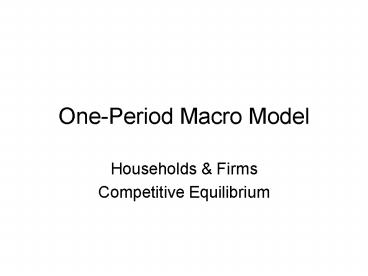One-Period Macro Model - PowerPoint PPT Presentation
Title:
One-Period Macro Model
Description:
One-Period Macro Model Households & Firms Competitive Equilibrium – PowerPoint PPT presentation
Number of Views:114
Avg rating:3.0/5.0
Title: One-Period Macro Model
1
One-Period Macro Model
- Households Firms
- Competitive Equilibrium
2
Households
- Chooses Labor Supply (Ns), leisure (l 1- Ns),
and consumption (c) to - subject to
- given w real wage rate and a household
wealth.
3
- Optimal values of c,l, given w and a, solves
4
- Implications
- (i) Changes in wealth creates a pure income
effect - dc/da gt 0
- dl/da gt 0 and dN/da lt 0
- (ii) Changes in real wages creates both an
income and substitution effect - dc/dw gt 0 and dN/dw ??
5
Figure 4.12 Real Wage in the United States,
19802003
6
Figure 4.13 Average Weekly Hours in the United
States, 19802003
7
The workweek and real GDP per person in 36
countries
8
Firms
- Chooses labor demand (Nd) and output Y to
maximize profits (P) - subject to
- (assuming fixed level of K)
- z Productivity/Technology Shock (Solow
Residual)
9
Figure 4.20 The Solow Residual for the United
States
10
- Optimal values of N,Y, given w, solves
- Implications
- (i) dN/dw lt 0 (Labor Demand Curve)
- (ii) dN/dz gt 0 (Productivity Shock)
11
Competitive Equilibrium (CE)
- Households ? c,Ns given a and w.
- Firms ? Y,Nd given w.
- Households are the owners of firms and takes
profits as given a P Y wN - Market-Clearing
- Nd Ns N 1l (labor mkt)
- Y c (Goods Mkt)
12
- A competitive equilibrium is c,N,Y,w
solving
13
Pareto Optimality
- An allocation is Pareto Optimal if no other
feasible allocation can make someone else better
off without making anyone else worse off. - The competitive equilibrium (CE) is Pareto
Optimal. - Verify Social Planning Problem / Robinson
Crusoe.
14
Productivity Shocks
- An increase in z
- Income effect ? () C and () l
- Substitution Effect ? () C and (-) l
- Hence dc/dz gt 0 and dN/dz ??
- In the case where both effects are roughly equal,
Y and w increases. - Classic Example is energy prices and GDP.
15
Figure 5.11 Deviations from Trend in Real GDP
and the Solow Residual
16
Figure 5.12 The Relative Price of Energy
17
One Period CE Model with Government
- Government sector
- (i) Collects revenues from taxes (T).
- (ii) Purchases goods and services (G)
- Assume balanced budget (G T)
- Household wealth (a) P - T
- Goods Market Clearing Y C G
- Labor market Clearing Nd Ns
18
CE Model with Government
- Households ? c,Ns given a and w.
- Firms ? Y,Nd given w.
- Households are the owners of firms and takes
profits as given a P-T - Market-Clearing
- Nd Ns N 1l (labor mkt)
- Y cG (Goods Mkt)
19
- A competitive equilibrium given G is
c,N,Y,w solving
20
Effects of Government Purchases
- Negative Income Effect
- dc/dG lt 0
- dl/dG lt 0 ? dN/dG and dY/dG gt 0
- du(c,l)/dG lt 0
- Stabilization Policy The government can use
government purchases to stabilize output from
productivity shocks (dG/dz gt 0) but it will lead
to a further decrease in economic welfare.
21
The Growth Rate of U.S. Real Gross Domestic
Product since 1870
22
Figure 5.7 GDP, Consumption, and Government
Expenditures
23
Comparison with IS-LM
- Both predict
- (i) dY/dG gt 0
- (ii) Government purchases can be used to
stabilize GDP and business cycles. - Differences
- (i) CE model predicts dC/dG lt 0
- (ii) There is full crowding out of consumption
- (iii) Fiscal policy will not improve welfare of
the representative consumer.

